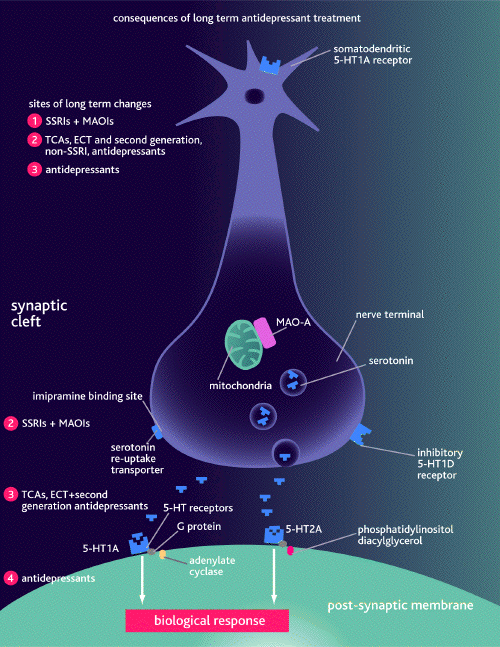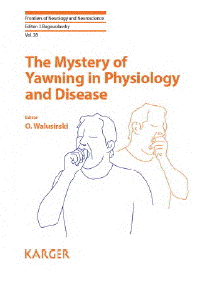- Bâillements
et
dépression
- Yawning
and depression
- Le
bâillement: de la physiologie à la
iatrogénie
- Yawning:
from physiology to iatrogenic
effect
-
- Yawning occurs after waking up, before
eating, before sleeping, and in passive
activities when it is necessary to maintain a
certain level of vigilance. Nevertheless, it is
also a clinical sign in intracranial
hypertension, migraine, or iatrogenic side
effects of dopaminergic drugs and serotonin
reuptake inhibitors. Here, we report a case of a
39- year- old male patient who developed
excessive yawning due to the antidepressant drug
venlafaxine. He had been alcohol-dependent in
the past and also had nonspecific anxiety
symptoms. The probable causes and possible
hypotheses are discussed below.
-
- Yawning is a physiological behavior, an
emotional stereotypy that indicates the
homeostatic process of the mechanisms regulating
rhythms, such as sleeping /waking, hunger/
satiety, or mating/relaxation, and generated by
the diencephalon.
- Nevertheless, it is also a clinical sign in
intracranial hypertension, migraine, or
iatrogenic side effects of dopaminergic drugs
and serotonin reuptake inhibitors.
Antidepressants are known to induce yawning.
Reports are available with imipramine,
desipramine, clomipramine, fluoxetine,
paroxetine, duloxetine, sertraline, and
escitalopram. There is only one case report on
venlafaxine in the previous literature.
-
- Case Report A 39-year-old male
patient from an urban background visited the
Department of Psychiatry for the complaints of
excessive yawning and vague anxiety symptoms.
The patient had been alcohol-dependent for 10
years, but had quit the habit 6 years ago.
Later, he had anxiety symptoms after renouncing
alcohol intake. For the complaint of anxiety, he
consulted a private psychiatrist 1 year earlier.
Initially, he was given venlafaxine capsules,
37.5 mg/day. Then the dose was increased up to
150 mg/day over 2 weeks. Later, the patient
returned with decreased anxiety symptoms, but at
the same time, there was excessive yawning just
after starting the drug, which worsened as the
dose was increased. So he again visited the same
private psychiatrist, where it was suggested to
taper the dose. After 6 months, he was asked to
stop the drug. There was a reduction in yawning
after tapering the dose, and symptoms completely
stopped once the drug was withdrawn. After 15
days of withdrawal, he had a recurrence of
anxiety symptoms, and, once more, the private
psychiatrist restarted venlafaxine at 75 mg/day.
Once again, he had excessive yawning, and he
reported to our department. His personal drug
history was taken, and other causes for yawning
were ruled out. As the patient did not have any
specific anxiety or depressive disorders, he was
advised to taper and finally to stop
venlafaxine. Later, he was treated with
relaxation and behavioral therapy and was asked
to follow up. The patient has been free from
yawning and anxiety symptoms for the last 3
months.
-
- Discussion The main center that
controls yawning is the hypothalamic
paraventricular nucleus (PVN). The PVN is a
point of integration between the central and
peripheral autonomic systems. A group of
oxytocin neurons situated in parvocellular zone
of the PVN and projecting to the hippocampus,
the brainstem (locus ceruleus), and the spinal
cord control yawning. The stimulation of these
neurons by dopamine or its agonists, such as
excitatory amino acids (NMDA), histamine, and
oxytocin itself, triggers yawning, whereas GABA
and opioids have an inhibitory effect.' This
pathway is also modulated by acetylcholine,
serotonin, sexual hormones, and orexin.
-
- Serotonin is a vasoactive compound that
regulates skin blood flow, which is a major
mechanism in thermoregulation. Increases in
serotonin have been linked to increases in brain
temperature and core body temperatures. The
available evidence suggests that excessive
yawning in patients taking SSMs may be a
consequence of increases in brain temperature
and core body temperature produced by these
drugs.
-
- In the current case report, the patient had
been alcohol-dependent for 10 years-long enough
for alcohol to cause at least some CNS damage.
Previous literature notes that alcohol may act
directly on the central pacemaker to alter
circadian functioning and thermoregulation.
Altered thermoregulation is one of the proposed
hypotheses for yawning induced by
antidepressants. In the present case, patient
may already have had impaired thermoregulation,
and antidepressants such as venlafaxine worsened
the condition; as a result patient show
excessive yawning. Another hypothesis is that
venlafaxine has its effect through serotonin,
norepinephrine, and dopamine neurotransmitters,
which have direct or indirect connections with
the yawning pathway. These mechanisms
subsequently lead to yawning with venlafaxine
use. It also clear from the present case that
venlafaxine can lead to excessive yawning even
at lower dosage, and the problem can worsen at
the higher doses. To conclude: excessive yawning
is both a physical and a social problem. Prompt
change in drug/therapy will benefit the
patient.
-
- Raghavendra Nayak, M.D. Ghovind S. Bhogale,
M.D. Nanasaheb M. Patil, M.D.
-
- Philibert
C, Sauveplane K, Pinzani-Harter V et al. Le
bâillement: de la physiologie à la
iatrogénie. La lettre du pneumologue.
2011;14(5):168-172
-
- References
-
- 1. Walusinski
O: Yawning in diseases. Eur Neurol 2009;
62:180&endash;187
- 2. Perriol MP, Monaca C: "One person's
yawning sets off everyone else's." J Neurol
Neurosurg Psychiatry 2006; 77:3
- 3. Chen CH,
Lu ML: Venlafaxine-induced excessive
yawning. Prog Neuropsychopharmacol Biol
Psychiatry 2009; 33:156&endash; 157
- 4. Gallup
AC, Gallup GG Jr: Yawning and
thermoregulation. Physiology Behav 2008;
95:10&endash;16
- 5. Wasielewski JA, Holloway FA: Alcohol's
interactions with circadian rhythms: a focus on
body temperature. Alcohol Res Health 2001;
25:94&endash;100
- 6. Gallup
AC, Gallup GG Jr: Venlafaxine induced
excessive yawning: a thermoregulatory
connection. Prog Neuropsychopharmacol Biol
Psychiatry 2009; 33:747
-
-

|



